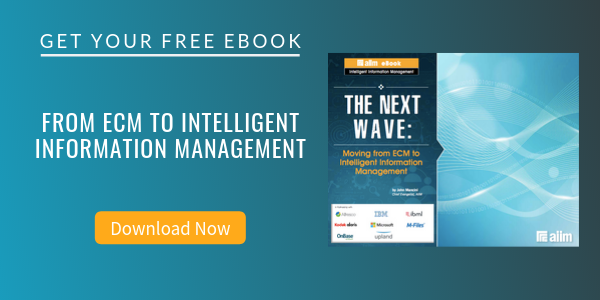
8 Steps to an Effective ECM Archive Migration
Enterprise Content Management (ECM) | Archiving
With the vast number of disparate systems in an organization, along with their relative complexity and enormous amounts of data, ECM migrations can be daunting. This brief list of eight considerations in undertaking an ECM migration is meant to provide a common-sense approach to addressing the process.
1. Business justification and ROI.
A critical consideration in any ECM migration project is establishing ROI and approaches to measurement. Without these elements, getting funding will be a challenge. The first step is to build out a simple executive summary focusing on what’s in it for the various groups involved, along with reasons for initiating the project in the first place and the anticipated outcome. Focus on a specific dollar figure for those concentrating on the bottom line – whether it’s savings in storage or bandwidth, maintenance costs for ECM, or staffing costs. Consider making an initial decision on whether to federate, migrate, or do nothing.
2. Take time to improve your business.
Take just one moment to understand what additional capabilities may be realized by the migration. New solutions will often include new capabilities, and while they may not be on your list of requirements, they could be capabilities worth implementing. However, any project should be focused on improving ease of use and increasing productivity. By switching to a new and improved ECM system, we can realize additional benefits in these areas. Reducing document storage costs, re-indexing for additional organization, or enhancing ePresentment are all good examples. And since we don’t need to turn everything on from day one, keep an eye on the ball and what the business really needs.
3. Expertise counts.
No matter what a particular vendor says, ECM migrations can be complicated, but they are also well worth the investment when done right. One of the keys to success is expertise. Having individuals on the project team with the proper background and a solid understanding of both traditional and new approaches can significantly increase your chances of success. Since it's a skill set that may not exist internally, you need to weigh the pros and cons of allocating funds for training staff. More often than not, however, working with a 3rd party vendor or hiring to get the expertise required will do the trick.
4. It's about Experience.
Training and skills can only take you so far. When it comes to ECM migration, you need individuals with experience. Having project members who have been through past migrations can prove invaluable to the overall project and its success. Again, if the experience does not exist in-house, it’s worth investigating a new hire or working with a vendor well versed in such projects.
5. It's about Methodology.
The actual migration – moving of the data – is the easy part. In most cases, a migration can take a number of days. To get the organization to this stage, you need to have a good plan and, more importantly, a methodology. Teams require a vision as to how this project can be accomplished. So don’t just “wing it” – adopt a formal methodology around the practice and follow through. Don’t have time to investigate? Use this simple acronym as a starting point: DETAIL (Discovery, Extract, Transform, Audit, Index, and Load).
6. It's ALL about the technology.
Map out all the moving pieces. If you are looking to automate, how many files will be moved, and over how long? What formats are you moving from and going to? What about platforms? Mainframe to distributed, Unix, Linux, Windows? Are you running each step manually, or building/buying various toolkits and components to get the job done? Don’t overcomplicate things, just build the lists and organize them appropriately. When you need an answer, it will be readily available. Understanding the technology taxonomy will prove to be a critical exercise, and should not be overlooked.
7. Define your approach.
ECM migrations don’t happen in minutes, but they don’t take years either. If you’re dealing with terabytes upon terabytes of data, it will take time to move over this content. So ask the question: how is it best delivered in a timely and cost-effective manner? Onsite, offsite, remotely, or SaaS? Choose the best option for the business, but keep in mind the potential timeline for the actual transferring of the content itself.
8. Keep it simple.
This old adage is still very valid. Just because a project can be huge, it doesn't have to be difficult. Break down actionable items into simple project plans with dates and ownership. Outsourcing to an experienced vendor can often alleviate much of the day-to-day tasks and make things simpler, at least for you!
About John Mancini
John Mancini is the President of Content Results, LLC and the Past President of AIIM. He is a well-known author, speaker, and advisor on information management, digital transformation and intelligent automation. John is a frequent keynote speaker and author of more than 30 eBooks on a variety of topics. He can be found on Twitter, LinkedIn and Facebook as jmancini77. Recent keynote topics include: The Stairway to Digital Transformation Navigating Disruptive Waters — 4 Things You Need to Know to Build Your Digital Transformation Strategy Getting Ahead of the Digital Transformation Curve Viewing Information Management Through a New Lens Digital Disruption: 6 Strategies to Avoid Being “Blockbustered” Specialties: Keynote speaker and writer on AI, RPA, intelligent Information Management, Intelligent Automation and Digital Transformation. Consensus-building with Boards to create strategic focus, action, and accountability. Extensive public speaking and public relations work Conversant and experienced in major technology issues and trends. Expert on inbound and content marketing, particularly in an association environment and on the Hubspot platform. John is a Phi Beta Kappa graduate of the College of William and Mary, and holds an M.A. in Public Policy from the Woodrow Wilson School at Princeton University.



